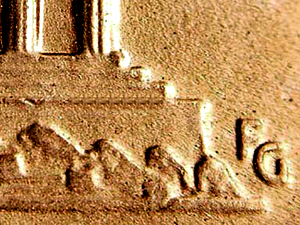Answers to Your Recent Coin Questions
By Dr. Sol Taylor
Q. Why is the dime so much smaller than the nickel?
Q. Do all of our coins have the designer's initials?
"Making Cents"
The Signal
Saturday, May 27, 2006
A. In the 1870s, the dime and half dime were both made of silver, with the half dime being half the weight of the dime. In 1866, a nickel alloy five-cent coin was minted to replace the very small half dime. Both circulated for a few years, and by 1873, the half dime was no longer made. The five-cent nickel then became known simply as a "nickel." The silver dime, however, remained for almost another century as a 90-percent silver coin (our smallest-sized coin). In 1964, when the last silver dimes were minted, the newer, clad copper-nickel dime was made the same size to accommodate vending machines and mechanical coin-counting machines. Today it makes no sense to make the nickel so much bigger than a dime, since both are made of basically the same alloy.
|
Q. I own several coins with ANACS certificates. I tried selling them to various dealers at a major coin show and was disappointed at the wide range — low, in my view — of prices offered. Why is this so?
A. The ANACS-certified coins are essentially obsolete in terms of grading services. Since 1985, the preferred certified services have provided a sealed ("encapsulated") holder with a single grade. It may be worthwhile to submit these coins to one of the top-tier grading services to be encapsulated. Then they not only would be easier to sell, but at competitive prices. Ask any dealer what services they prefer in terms of buying coins.
Q. My 1968-79 proof sets show spotting on several coins. I thought the holders were protected against tarnish and spotting. What can I do?
A. The holders of this period have proved to be less than 100-percent effective in long-term protection from the elements. In fact, some coins were compromised as they were being sealed in the holders. Since the 1990s, the process of sealing the coins has assured a much higher success rate for long-term storage. It is suggested you break open the holders and assemble sets in custom, three-piece holders of the unblemished coins and sell the spotted coins for whatever you can get.
Q. My late great uncle owned a dairy in New Jersey dating back to the late 1800s. He died in 1965. In his estate, he had lots of material from his dairy, including several dozen small, round brass tokens stamped with the name of his dairy and "Good For One Quart." I showed them to a few coin dealers, and only two made an offer — of about 25 cents each. I am sure they have a higher value. How do I find out?
A. The Token and Medal Society (TAMS), as well as Russ Rulau's book on tokens of the 19th Century, are two good resources to see if such tokens are even listed. If not, they might make an excellent item for a major coin auction such as Heritage.com. Try selling a few on eBay.
Q. I have a strip on old $1 bills, Series 1934, taped together to make a 3-foot-long strip. Each note has numerous signatures, dates and messages. I was told this is called a "short snorter." What does that mean?
A. During World War II, servicemen would attach $1 bills in a series, using tape or even glue, and sign each note as they spent them. Each additional note represented another owner in the sequence. These are very collectible both as old currency (silver certificates), but more for their historic value. Do not separate them, since they are like parts of a diary. I do not know the origin of the term "short snorter."
Dr. Sol Taylor of Sherman Oaks is president of the Society of Lincoln Cent Collectors and author of The Standard Guide to the Lincoln Cent. Click here for ordering information.
©2006, THE SIGNAL · ALL RIGHTS RESERVED.
